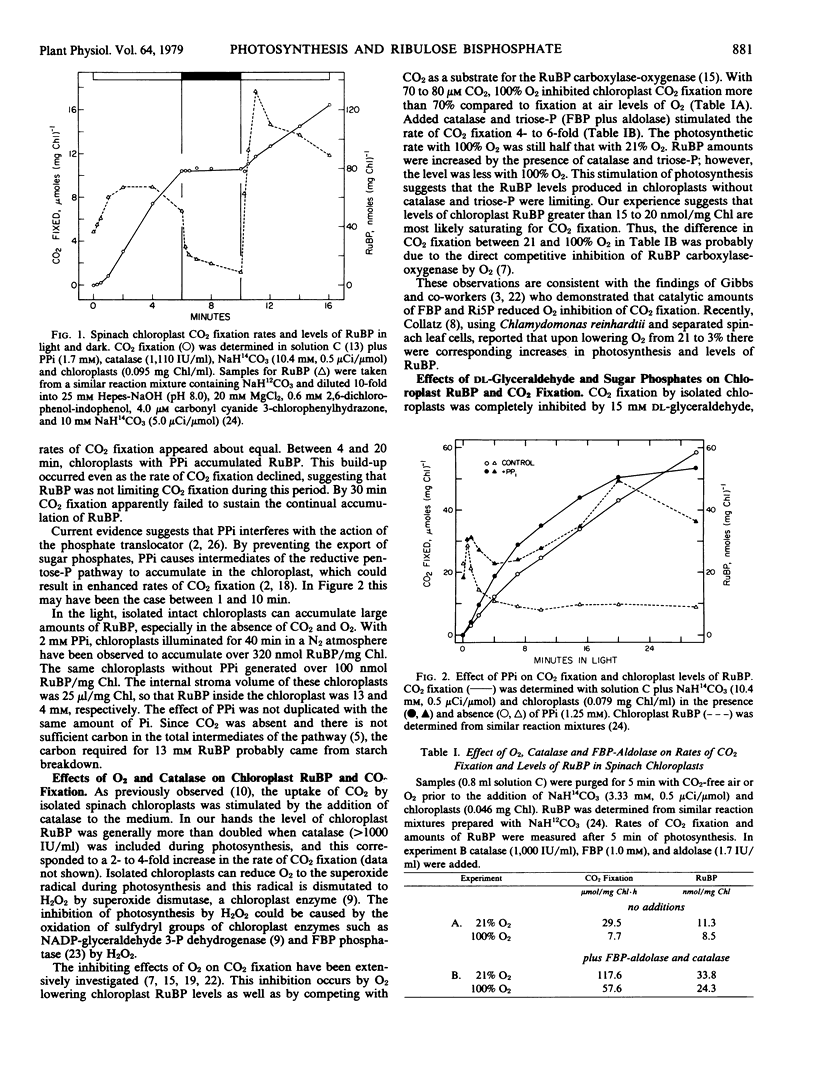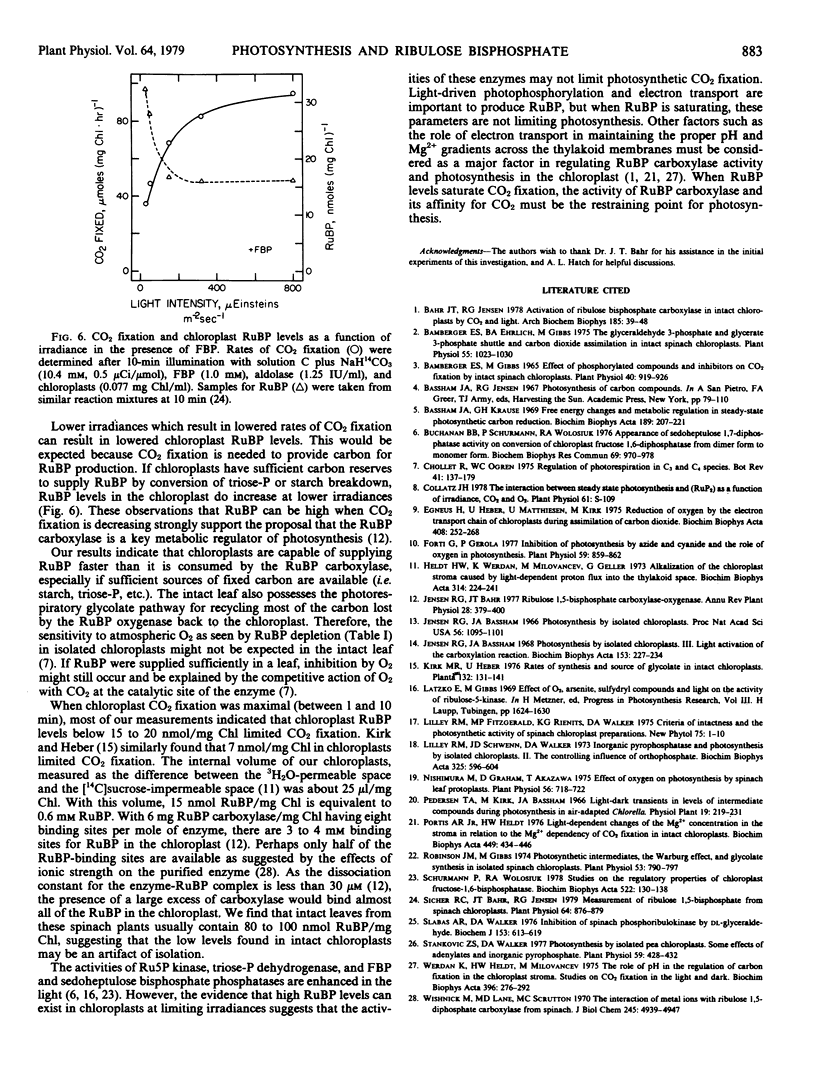Abstract
The response of ribulose 1,5-bisphosphate levels and CO2 fixation rates in isolated, intact spinach chloroplasts to pyrophosphate, triose phosphates, dl-glyceraldehyde, O2, catalase, and irradiance during photosynthesis has been studied. Within 1 minute in the light, a rapid accumulation of ribulose bisphosphate was measured in most preparations of intact chloroplasts, and this subsequently dropped as CO2 fixation increased. Pyrophosphate, triose phosphates, and catalase increased CO2 fixation and also the levels of ribulose bisphosphate. CO2 fixation was inhibited by dl-glyceraldehyde and O2 with corresponding decreases in ribulose bisphosphate. When the rate of photosynthesis decreased at limiting irradiances (low light), the level of ribulose bisphosphate in the chloroplast did not always decrease, suggesting that ribulose bisphosphate was not limiting CO2 fixation under these conditions. When triose phosphates (fructose bisphosphate plus aldolase) were added to suspensions of chloroplasts at low irradiances, ribulose bisphosphate increased while CO2 fixation decreased. These observations provide considerable evidence that high ribulose bisphosphate levels clearly are not solely sufficient to permit rapid rates of CO2 fixation, but that factors other than ribulose bisphosphate concentration are overriding the control of photosynthesis.
Isolated chloroplasts are capable of using carbon reserves to produce considerable ribulose bisphosphate. Upon illumination in the absence of CO2 and O2, intact chloroplasts produced up to 13 millimolar ribulose bisphosphate.
Full text
PDF



Selected References
These references are in PubMed. This may not be the complete list of references from this article.
- Bahr J. T., Jensen R. G. Activation of ribulose bisphosphate carboxylase in intact chloroplasts by CO2 and light. Arch Biochem Biophys. 1978 Jan 15;185(1):39–48. doi: 10.1016/0003-9861(78)90141-8. [DOI] [PubMed] [Google Scholar]
- Bamberger E. S., Ehrlich B. A., Gibbs M. The glyceraldehyde 3-phosphate and glycerate 3-phosphate shuttle and carbon dioxide assimilation in intact spinach chloroplasts. Plant Physiol. 1975 Jun;55(6):1023–1030. doi: 10.1104/pp.55.6.1023. [DOI] [PMC free article] [PubMed] [Google Scholar]
- Bamberger E. S., Gibbs M. Effect of Phosphorylated Compounds and Inhibitors on CO(2) Fixation by Intact Spinach Chloroplasts. Plant Physiol. 1965 Sep;40(5):919–926. doi: 10.1104/pp.40.5.919. [DOI] [PMC free article] [PubMed] [Google Scholar]
- Bassham J. A., Krause G. H. Free energy changes and metabolic regulation in steady-state photosynthetic carbon reduction. Biochim Biophys Acta. 1969 Oct 21;189(2):207–221. doi: 10.1016/0005-2728(69)90048-6. [DOI] [PubMed] [Google Scholar]
- Buchanan R. B., Schfürmann P., Wolosiuk R. A. Appearance of sedoheptulose 1,7-diphosphatase activity on conversion of chloroplast fructose 1,6-diphosphatase from dimer form to monomer form. Biochem Biophys Res Commun. 1976 Apr 19;69(4):970–978. doi: 10.1016/0006-291x(76)90468-x. [DOI] [PubMed] [Google Scholar]
- Egneus H., Heber U., Matthiesen U., Kirk M. Reduction of oxygen by the electron transport chain of chloroplasts during assimilation of carbon dioxide. Biochim Biophys Acta. 1975 Dec 11;408(3):252–268. doi: 10.1016/0005-2728(75)90128-0. [DOI] [PubMed] [Google Scholar]
- Forti G., Gerola P. Inhibition of photosynthesis by azide and cyanide and the role of oxygen in photosynthesis. Plant Physiol. 1977 May;59(5):859–862. doi: 10.1104/pp.59.5.859. [DOI] [PMC free article] [PubMed] [Google Scholar]
- Heldt W. H., Werdan K., Milovancev M., Geller G. Alkalization of the chloroplast stroma caused by light-dependent proton flux into the thylakoid space. Biochim Biophys Acta. 1973 Aug 31;314(2):224–241. doi: 10.1016/0005-2728(73)90137-0. [DOI] [PubMed] [Google Scholar]
- Jensen R. G., Bassham J. A. Photosynthesis by isolated chloroplasts. 3. Light activation of the carboxylation reaction. Biochim Biophys Acta. 1968 Jan 15;153(1):227–234. doi: 10.1016/0005-2728(68)90164-3. [DOI] [PubMed] [Google Scholar]
- Jensen R. G., Bassham J. A. Photosynthesis by isolated chloroplasts. Proc Natl Acad Sci U S A. 1966 Oct;56(4):1095–1101. doi: 10.1073/pnas.56.4.1095. [DOI] [PMC free article] [PubMed] [Google Scholar]
- Lilley R. M., Schwenn J. D., Walker D. A. Inorganic pyrophosphatase and photosynthesis by isolated chloroplasts. II. The controlling influence of orthophosphate. Biochim Biophys Acta. 1973 Dec 14;325(3):596–604. doi: 10.1016/0005-2728(73)90219-3. [DOI] [PubMed] [Google Scholar]
- Nishimura M., Graham D., Akazawa T. Effect of oxygen on photosynthesis by spinach leaf protoplasts. Plant Physiol. 1975 Nov;56(5):718–722. doi: 10.1104/pp.56.5.718. [DOI] [PMC free article] [PubMed] [Google Scholar]
- Portis A. R., Jr, Heldt H. W. Light-dependent changes of the Mg2+ concentration in the stroma in relation to the Mg2+ dependency of CO2 fixation in intact chloroplasts. Biochim Biophys Acta. 1976 Dec 6;449(3):434–436. doi: 10.1016/0005-2728(76)90154-7. [DOI] [PubMed] [Google Scholar]
- Robinson J. M., Gibbs M. Photosynthetic intermediates, the warburg effect, and glycolate synthesis in isolated spinach chloroplasts. Plant Physiol. 1974 Jun;53(6):790–797. doi: 10.1104/pp.53.6.790. [DOI] [PMC free article] [PubMed] [Google Scholar]
- Sicher R. C., Bahr J. T., Jensen R. G. Measurement of ribulose 1,5-bisphosphate from spinach chloroplasts. Plant Physiol. 1979 Nov;64(5):876–879. doi: 10.1104/pp.64.5.876. [DOI] [PMC free article] [PubMed] [Google Scholar]
- Slabas A. R., Walker D. A. Inhibition of spinach phosphoribulokinase by DL-glyceraldehyde. Biochem J. 1976 Mar 1;153(3):613–619. doi: 10.1042/bj1530613. [DOI] [PMC free article] [PubMed] [Google Scholar]
- Stankovic Z. S., Walker D. A. Photosynthesis by isolated pea chloroplasts: some effects of adenylates and inorganic pyrophosphate. Plant Physiol. 1977 Mar;59(3):428–432. doi: 10.1104/pp.59.3.428. [DOI] [PMC free article] [PubMed] [Google Scholar]
- Werdan K., Heldt H. W., Milovancev M. The role of pH in the regulation of carbon fixation in the chloroplast stroma. Studies on CO2 fixation in the light and dark. Biochim Biophys Acta. 1975 Aug 11;396(2):276–292. doi: 10.1016/0005-2728(75)90041-9. [DOI] [PubMed] [Google Scholar]
- Wishnick M., Lane M. D., Scrutton M. C. The interaction of metal ions with ribulose 1,5-diphosphate carboxylase from spinach. J Biol Chem. 1970 Oct 10;245(19):4939–4947. [PubMed] [Google Scholar]


